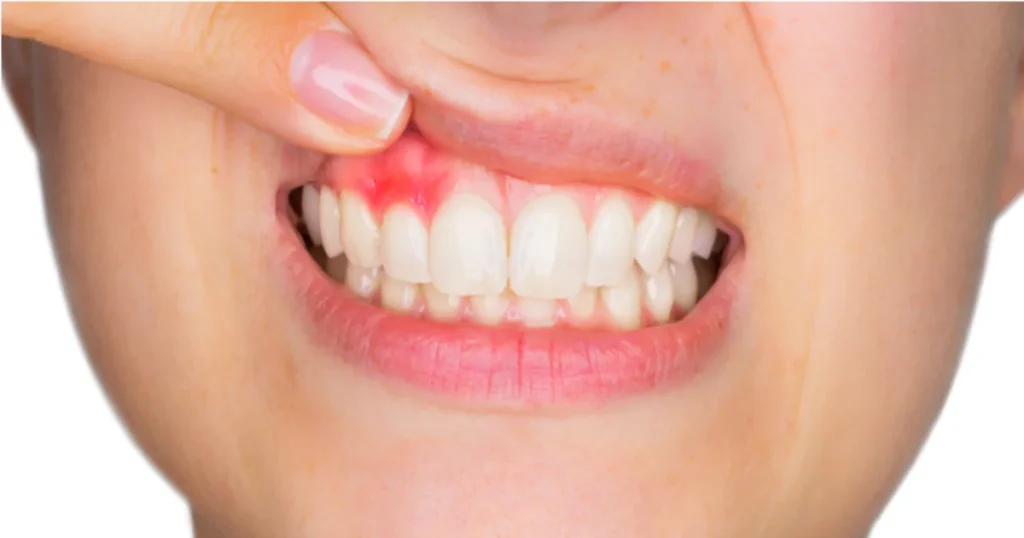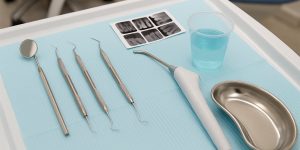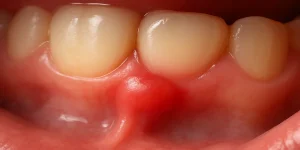A gum abscess is a painful, swollen pocket of pus that develops due to a bacterial infection in the gums. While it may seem tempting to pop it for temporary relief, doing so can worsen the infection and lead to more serious complications such as sepsis. Immediate dental care is essential to safely drain the abscess and prevent it from spreading, as well as maintain good dental hygiene.
In this article, we’ll explain why you should never pop a gum abscess, how to handle it until you can see a dentist, the professional treatments available, and tips to prevent future abscesses from forming. By the end of this article, you’ll have a clear understanding of how to approach this dental issue and when to seek urgent care.
Why Popping a Gum Abscess Is Risky
These are the main reasons why popping a gum abcess is risky:
Infection Spread
Popping a gum abscess might seem like a quick fix, but it can push bacteria deeper into the gum tissue and increase the risk of the infection spreading. This can lead to severe complications like sepsis, a life-threatening infection that can spread throughout the body. Only a dentist can safely drain the abscess and treat the infection to prevent it from spreading.
Increased Pain and Swelling
While popping an abscess may provide temporary relief, it often worsens the situation. The infection can spread deeper, causing more swelling, pain, and potentially filling with pus. This increases discomfort and makes the infection harder to treat effectively.
Potential Damage to Surrounding Tissue
Attempting to pop the abscess can cause unnecessary damage to your gums, teeth, and the bone underneath. This may lead to more invasive treatments, such as root canals, in the future. Proper professional care ensures the infection is managed without causing further damage to your oral health.

Safe At-Home Care Until You See a Dentist
While it’s best to consult a dentist as soon as possible, there are a few things you can do at home to manage a gum abscess until you can see your dentist:
- Salt and Water Rinse
A warm salt-water rinse is one of the most effective ways to manage a gum abscess at home. Salt has natural antibacterial properties that help reduce swelling, clean the infected area, and alleviate discomfort. Rinse your mouth with warm salt water 2-3 times a day. - Pain Relief with Medication
Over-the-counter pain relievers, such as ibuprofen or acetaminophen, can help reduce the pain and swelling caused by the abscess. Always follow the recommended dosage and consult with your dentist if you have any concerns. - Antibiotics
While not always necessary, your dentist may prescribe antibiotics to control the infection, especially if it is spreading. This will help manage the infection until you can receive professional care.
Note: These home remedies offer temporary relief, but they are not substitutes for professional treatment. Be sure to make an appointment with your dentist as soon as possible.
Professional Treatment Options for a Gum Abscess
When you see a dentist, they will assess the gum abscess and recommend a treatment plan that may include one of the following options:
- Periodontal Therapy
If the abscess is caused by gum disease, your dentist will likely recommend scaling and root planing. This deep cleaning procedure removes plaque and tartar from below the gumline, helping to treat the infection and prevent it from recurring. You should also have sufficient knowledge about oral hygiene and common pediatric dentistry. - Root Canal Treatment
If the abscess has spread to the tooth’s root, a root canal may be necessary to remove the infected tissue and seal the tooth. This treatment is essential to prevent the infection from worsening and to save the tooth. - Tooth Extraction
If the infection has severely damaged the tooth, your dentist may recommend a tooth extraction to stop the infection from spreading further. While extraction may seem extreme, it’s often the best solution to protect your overall oral health. - Abscess Drainage
If the abscess is large, your dentist will drain the pus from the infection to relieve the pressure and reduce swelling. This procedure helps to eliminate the source of the infection.
Each of these treatments is performed by a skilled dentist to ensure your gums and teeth heal effectively, and the infection is properly controlled.
Need Advanced Gum Abscess Treatment?
If you’re concerned about a gum abscess, contact our team to schedule an appointment and receive expert care.
When to See a Dentist Immediately
If you suspect that you have a gum abscess, it’s important to seek professional care promptly. Ignoring the symptoms or delaying treatment can lead to more serious complications, some of which may require urgent dental intervention. Here are the key signs that should prompt you to see a dentist immediately:
Severe Pain That Doesn’t Subside
While a gum abscess typically causes discomfort, the pain should not be unbearable or constant. If the pain worsens despite using over-the-counter pain relievers or if it becomes so intense that it interferes with your daily activities, it’s time to visit a dentist. Persistent pain often signals that the infection is spreading or that the abscess needs professional drainage.
Swelling
If you notice significant swelling in your gums that extends to your face, neck, or jaw, this is a sign that the infection is spreading. Swelling in these areas can also indicate that the abscess is deep or the infection is becoming systemic. In severe cases, it may interfere with your ability to swallow or breathe, which requires emergency dental care.
Fever or Chills
Fever and chills are common symptoms of infection spreading throughout the body. If you experience these symptoms alongside the abscess, it could be a sign that the infection has progressed to a more serious stage, such as sepsis. Sepsis is a life-threatening condition that requires immediate medical attention and is often caused by untreated dental infections.
Difficulty in Swallowing
If the infection from the gum abscess spreads to the throat or respiratory system, it can cause difficulty swallowing, breathing, or both. This is a medical emergency. The swelling from the abscess can block the airway, leading to potential complications if not treated right away.
Pus Draining from the Abscess
If you notice pus draining from the gum abscess, it indicates that the infection has reached a point where it is actively being expelled. However, while this may provide some temporary relief, it also means the infection is still present and can continue to spread if not treated properly.
Increased Tenderness
If your gums appear tender than usual, it could be a sign that the infection is worsening. Healthy gums should be firm and pink, while infected gums will often appear swollen, red, and painful.

Prevention Tips to Avoid Future Gum Abscesses
To prevent future gum abscesses, it’s important to maintain healthy gums and teeth. Here are some key tips to help you avoid future infections:
- Proper Oral Hygiene: Brush your teeth twice a day with fluoride toothpaste and floss daily to remove plaque and food particles that contribute to gum disease.
- Regular Dental Visits: Schedule regular cleanings and checkups with your dentist. Regular visits help catch any early signs of gum disease before they progress to more serious conditions like gum abscesses.
- Quit Smoking: Smoking damages your gums and makes them more susceptible to infection. Quitting can significantly reduce your risk of developing gum abscesses.
- Healthy Diet: Eating a balanced diet that supports your overall health can also benefit your gums and teeth.
Besides the prevention tips, you must know that abscesses are urgent, and even the Mayo Clinic website has said this about the urgency of them:
“Most periodontal abscesses aren’t life-threatening. But because the infection can spread, it’s important to treat it as quickly as possible. Though it’s rare, an untreated periodontal abscess can result in sepsis and other life-threatening conditions.”
Read more: Types of Cosmetic Dentistry
Why Professional Care Is Essential for Gum Abscesses
A gum abscess is a serious condition that should never be ignored. While attempting to pop the abscess may seem like a quick fix, it can lead to dangerous complications. Professional treatment, such as root canal therapy, scaling and root planing, or tooth extraction, is the safest and most effective way to manage the infection and restore your oral health.
At Leslie North Dental, we specialize in treating gum abscesses with safe, effective methods. Whether you need oral hygiene tips, periodontal therapy, or more advanced treatments like root canals or tooth extractions, we have the expertise to restore your smile and prevent future abscesses.
FAQ
Here are the most frequently asked questions about gum abscesses:
What’s the difference between a gum abscess and a cyst?
A gum abscess is an infected pocket of pus caused by bacteria, while a cyst is typically a non-infected, fluid-filled sac. Abscesses require immediate attention to prevent the infection from spreading.
Can a gum abscess go away on its own?
A gum abscess usually won’t resolve without professional care. At-home remedies may provide temporary relief, but a dentist is needed to drain the infection and treat its cause.
How long does a gum abscess take to heal?
After receiving proper treatment, such as scaling and root planing or a root canal, a gum abscess can heal within a few days to a week.
Are antibiotics always needed?
Antibiotics may be prescribed in some cases to control the infection, but they are not always necessary. Your dentist will assess your condition and determine whether antibiotics are necessary.
How can I prevent future gum abscesses?
Regular oral hygiene and dental checkups, along with avoiding smoking, are the best ways to prevent gum abscesses in the future.
Have you dealt with a gum abscess before, or have any questions about treatment?
Share your thoughts.
Our team at Leslie North Dental is here to answer your questions and provide expert advice!





